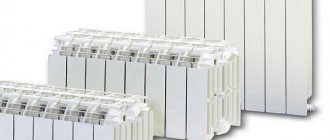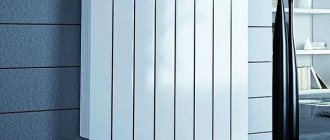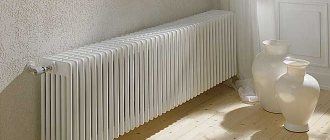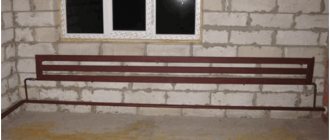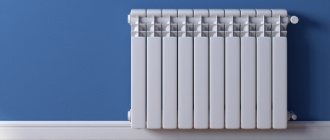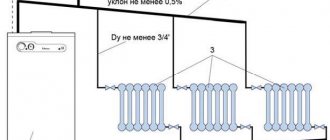To effectively heat rooms with panoramic glazing or sufficiently wide “French” windows, a non-standard solution will be required. One of the possible options is to install low radiators, which guarantee high-quality heating of the apartment and also prevent the spread of cold and icing of the glass. This approach to solving the problem is the only correct one, except for cases when thermal curtains are used. In choosing the right type of radiators for panoramic windows, familiarity with the design features of these devices, as well as their advantages and disadvantages, will help.
Problems with large windows - why do they occur?
A French window is, by and large, a glass wall.
Its main advantage - a large glazing area - from the point of view of heating engineering becomes a disadvantage. This is why such windows often “cry”: at the slightest drop in temperature, condensation forms on the inner surface of the glass, which flows down and can form large puddles. If the temperature outside the window has gone into the “deep minus”, then the condensation at the bottom of the window will freeze, forming a layer of ice. In addition, freezing can occur along the perimeter of the structure, so heat loss will be enormous.
And the point is not that you bought low-quality windows - you just can’t argue with physics:
- The thermal conductivity of the window (even if you have chosen an energy-saving double-glazed window) will in any case be higher than that of the walls surrounding it. Thus, the glass becomes the coldest area in the room, and it is on it that moisture from the air will condense.
- Warm air rises and cold air sinks. This is why the lower part of the window, adjacent to the floor, will suffer: it is in this zone that the temperature will be the lowest. So freezing will start from here.
In the case of ordinary windows, the problem is solved by heating with radiators installed under the window sills. They already do a good job, but if you cut a special grill into the window sill board, condensation, if it appears, will only last for a few minutes.
This solution is not suitable for French windows: they do not have a window sill as such, and placing the radiator in front of the glass means significantly worsening the appearance of the entire structure. That is why to solve the problem of condensation and freezing you need to use special heating devices.
Kinds
Low radiators are a type of battery that differs from standard ones in its height. This parameter for such units is only 200-400 mm. Such devices are installed in rooms with large panoramic windows, in swimming pools, gyms, greenhouses, etc.
The main criterion on the basis of which types of low radiators are distinguished is the material of manufacture.
Cast iron
Batteries of this type are sections created by casting. Such devices have good thermal inertia and are resistant to corrosion. However, they have a low operating pressure, which reaches only 10 atm. In addition, they are very fragile. Users note that plaque often forms on the inner surface of the channels and dirt accumulates, which leads to a decrease in heat transfer. Therefore, you need to clean them periodically.
Steel
Steel panel radiators are constructed from one or more heating plates that are enclosed in a finned shell.
Their main positive characteristics:
- good thermal conductivity;
- low inertia;
- low coolant consumption.
Despite many good technical indicators, there are some disadvantages: such radiators cannot withstand water hammer and corrosion.
Reviews indicate that when water is drained, rust forms on the walls of the panels. Another disadvantage is that such heaters are not cheap. For example, if you want to purchase a radiator with a height of 300 mm, be prepared to pay from 2000 to 5000 rubles for it.
Aluminum
Low heating radiators made of aluminum have an attractive design, high heat transfer rates and are light in weight. They are characterized by high technical characteristics, thanks to which they are able to withstand operating pressures of up to 16 atm.
However, there are also some disadvantages. For example, aluminum radiators are short-lived: their service life is 10, in rare cases 15 years. Plus, such devices are not able to withstand hydraulic shocks, and as a result, leaks can form between sections.
The price of aluminum radiators varies from 300 to 1500 rubles.
Note! Aluminum batteries withstand water hammer better than cast iron ones, but their convection properties are much worse. Bimetallic
Bimetallic
The design of bimetallic models of low radiators consists of a core, which is made of steel or copper pipes, and an aluminum shell. Such batteries withstand high pressure well, consume a small amount of water and are resistant to corrosion processes.
Lamellar
Convector-type plate radiators are produced with the lowest heights; they can be attached to both the wall and the floor, and, if necessary, covered with decorative grilles. The devices have high heat transfer rates. The maximum pressure they can withstand is 20 atm. The disadvantage is that if there is a leak, it will not be possible to replace a part; you will have to buy a new radiator.
What batteries can be installed with a panoramic window
Irsap vertical radiators in interior design
Designers usually offer three solutions to the problem of heating a room with window openings almost to the floor:
- convectors built into the floor;
- low radiators;
- vertical devices.
All of these options have their advantages and disadvantages, so before making a choice, it is better to learn a little about the pros and cons of each type of heating device.
Average prices for services
In order not to damage expensive equipment, many owners turn to installation organizations. The cost of this work depends on the type of work and the selected equipment :
- insulation of slopes, 600 rub./m.p.;
- water “warm floor”, 20,000 rub./m.p.;
- electric “warm floor”, 14,000 rub./m.p.;
- warm baseboard, 8000 rub./m.p.;
- electric floor convector, 4800 rub./m.p.;
- high radiator, RUB 3,500/piece;
- low radiator, RUB 2,300/piece;
- electrically heated glass with maximum configuration, RUB 20,000. /1 m2.
Heating systems as an interior element
Each model line of heating equipment has a segment where radiators of small height are presented. This group includes products in which this parameter does not exceed 450 millimeters. A low heating radiator under a window is indispensable for heating constantly wet and cold walls facing the street along their entire length.
Such devices are used in the following cases:
- the presence of large panoramic windows;
- location of the heat supply system in the baseboards.
When choosing heating equipment, you need to take into account a number of technical parameters of the products:
- material of manufacture;
- dimensions;
- power;
- resistance to corrosion processes;
- scope, etc.
Areas and features of application, effectiveness
Model SOLIRA 2020/4 No. 12 with a height of 200 mm and a depth of 70 mm.
Narrow batteries have become an alternative to conventional batteries in the face of changing building standards. They are ideal for panoramic and stained glass windows. In addition, large radiators do not always fit into bathrooms, toilet rooms, and balconies. With their miniature size, low batteries are practically not inferior to standard analogues in terms of efficiency, if the installation is carried out without violating technology.
Low horizontal structures are used in narrow rooms where there are low walls, partitions or panoramic windows. They are also indispensable for small loggias and balconies, as they do not take up much space. Narrow horizontal radiators are also installed in long rooms and corridors.
The main feature of such radiators is not even the size and dimensions, but the specificity of heating the room: the lower and longer the heating device, the more even the temperature of the room and the better the entire volume of air is heated.
Operating principle
The radiators built into the floor heat the room using the convective principle. They themselves are also convectors by design. This system heats the room more efficiently than any wall-mounted radiator model. The heated air rises to the ceiling, the cooled air remains below and is heated, i.e. active circulation and uniform heating of the room occurs. It maintains a constant temperature. Heating costs are reduced.
Low Batteries: Pros and Cons
Low models are good because they can be installed under a window sill, which rises from the floor by a few centimeters. At the same time, the panoramic view will be preserved, and the problem of heating the room will be solved.
Low models of Irsap radiators in interior design Low models of Irsap radiators in interior design Low models of Irsap radiators in interior design
The main advantages of low tubular radiators are:
- low price;
- high heat transfer;
- ease of installation;
- large selection - you can choose the number of sections, width, depth of the device, tube diameter, color.
There are few disadvantages to this solution; they boil down to the fact that budget options, as a rule, have a rather primitive design, and beautiful designer models are not very cheap.
The lowest heating radiators
The standard, most commonly used height of radiators is 500 mm, less often - 300-400 mm. At the same time, it is still important to raise the device at least 60 mm above the floor. The lowest heating radiators for 2022 have a height of 155 mm. For example, these are tubular steel Vogel&Noot Delta 155 or Purmo Delta 155. Slightly higher are steel tubular radiators of horizontal type in 4 sections, their height is 180 mm. For example, this is Loten Gray Z 2000 for 4 sections or GUARDO RETTA 6P 180.
Among steel panel, aluminum and bimetallic ones, the lowest are radiators with an interaxial distance of 150 mm, but be careful, the total height of the device is usually 200 mm. The choice of such devices is huge; they are produced by almost all well-known manufacturers. We will consider the best of these models in more detail later.
Types depending on material of manufacture
Cast iron
Model RetroStyle Bolton 330/330.
Radiators made of this material are deservedly popular. Now they are performed in both standard and modern styles. Exclusive decorative floor samples are also produced.
Cast iron products have some advantages:
- high resistance of cast iron to the adverse effects of coolant and corrosion;
- huge service life of 30 years or more;
- The batteries take a long time to heat up, but cool down slowly.
However, there are many more disadvantages than advantages:
- low resistance to hydraulic shocks, they can withstand up to 10-12 atm (which is not always the limit in apartments of tall apartment buildings);
- low heat transfer;
- a large volume of coolant, which further reduces the efficiency of the heating system;
- heavy weight.
- specific and, despite all the attempts of manufacturers, relatively monotonous design.
Minimum required thermal power
Typically, thermal calculations of houses are done infrequently, so calculations have to be done room by room. The power of all radiators should be 20% higher than the power of the boiler. For a house insulated according to GOST, heat loss is 10 kW per 100 sq. m. with a ceiling height of up to 2.7 m.
Determining the number of radiators in each room by area is not always reasonable. Heat loss depends on walls, windows, doors. You shouldn't hang too many batteries either. But there should be enough of them so that the system is not hot (>70°C).
Here is an example of power distribution:
- The inner room is heated by the neighboring ones and can be equipped with a minimum number of radiators.
- External wall and window – 1 kW per 10 m2.
- A long outer wall and two windows - multiply the previous figure by 1.2.
- Two external walls and a window - multiply by 1.3.
- Two external walls and two windows - we multiply the primary data by 1.4 or 1.5.
This definition of power is relative. Much depends on other characteristics of the house: layout, size of external walls and windows. But for more than 90% of standard Russian houses, such a simple calculation is quite enough.
Horizontal radiators made of aluminum
The lowest aluminum heating radiators for panoramic windows have a height of 24.5 centimeters.
Similar models are produced by foreign companies:
- Sira. The company produces miniature radiators with heat output ranging from 89 to 97 W (products Rovall 80, Rovall 100, Swing, Alux 80 and Alux 100).
- Global. We offer a low cast radiator Gl-200/80/D, which is designed for installation in a heating system with an operating pressure of up to 16 Bar.
In this segment of domestic heating equipment, the most popular radiators are Rifar Base 200 and Rifar Forza 200. The number 200 indicates that their center distance is 20 centimeters.
Low horizontal heating devices made of aluminum have a number of important advantages:
- light weight - installation does not require the help of a team of builders;
- high degree of heat transfer;
- when the control valve is turned, the battery quickly responds to changes in operating environment parameters;
- A small volume of water is required to completely fill the system.
Of the negative characteristics of aluminum batteries, it should be noted:
- the chemical activity inherent in a given metal, which affects the quality of the water used;
- the softness of the manufacturing material, so the product is easily deformed.
The disadvantages of aluminum heating devices can be overcome if thorough water treatment is carried out before using them, which is recommended by the manufacturer’s instructions.
Manufacturers of aluminum radiators do not recommend using them in heat supply systems of multi-apartment buildings, where the quality of hot water is highly questionable.
If you plan to install an aluminum battery under panoramic windows, you should not forget that this metal has poor contact with copper and alloys that contain copper. Galvanized fittings function without problems with aluminum. You can also install wall-mounted electric heating radiators; they are also quite effective.
Types of structures
Depending on the material used for the production of radiators, several types of devices can be distinguished.
- Aluminum and cast iron. These are perhaps the “oldest” versions of radiators, which were first presented to consumers at the beginning of the last century. However, it is quite difficult to find floor products made of these metals; conventional batteries are much more common, which are simply attached to the floor using brackets. We can say that these are ordinary wall-mounted models that are simply attached to the floor.
- Bimetallic radiators. This type of heating devices includes those made of two metals; aluminum-copper and aluminum-steel are more common. The features of such radiators include the following point: the water inside them moves along a special core made of steel and characterized by high corrosion resistance.
- Steel. This version of radiators is quite widespread; convectors, registers and tubular models are made from this alloy. Convectors are characterized by the same design as their counterparts made of aluminum and copper, however, with the same dimensions, the degree of heat transfer of steel models is slightly lower.
Tubular modifications can have a wide variety of configurations, due to this they are often used not only for effective heating, but also as a decorative element in the room, a stylish accent of a modern interior. The registers look like the most basic homemade installations, they are produced quite quickly: thick pipes are simply connected to each other using special jumpers, which forms a closed circuit at the output. Such products can be used as an element of the heating system or autonomously.
Separately, you need to dwell on the types of heaters inside floor radiators.
Depending on the principle of operation, they are divided into electric and water.
- The first varieties work due to a special closed heating element on which metal plates are held; they can be copper or steel. The purpose of such discs is to maximize the surface area in contact with the air flow. Such radiators are characterized by a high degree of safety, since they are equipped with fuses for effective and reliable protection against any possible malfunctions in the electrical network.
- The operating principle of water models is slightly different. The main heating element here consists of metal pipes with several plates, which are attached to a centralized heating network using special pipes.
Depending on the type of model, a floor radiator may include a fan, this significantly increases the heat transfer of the device. Such a radiator operates from an electric current network and is supplemented with special vibration-proof supports, which greatly reduce the level of noise emitted.
For owners of non-standard rooms, radiators of a wide variety of shapes and the required radius of curvature can be manufactured according to individual projects. If you plan to use the device in homes with high humidity levels, then you should give preference to models made of stainless materials with a built-in drain for drainage. Some models have special electronic regulators that allow you to set the optimal temperature background. As a rule, a remote control is included with such products.
Built-in devices
Heating radiators built into the floor are used to heat office, retail and residential establishments. They can be used in greenhouses and conservatories to create temperature conditions that are comfortable for plants. The operation of the device is based on the principle of convection. Built-in units promote intensive air circulation, so they heat the room faster and more efficiently, which reduces heating costs.
Worth knowing! There are built-in radiators on sale with automatic temperature control, condensate removal function, and the ability to program the microclimate in the room.
The unit has a simple design. Inside the metal housing there is a heat exchanger with convective plates. The body of the device is built into the floor, and is covered with a durable decorative grille on top.
Brands
Profile
- Which profile systems should you prefer when choosing windows?
If a price difference of 15 - 20% is not critical for you, it is better to choose profile systems from famous German manufacturers - KBE or Rehau. From my own experience: they differ from inexpensive domestic and Chinese-made profiles in that they are more rigid. This quality is very useful when there is a large window area and, accordingly, significant wind loads.
Rehau profiles have high rigidity due to the significant thickness of the steel liner.
Cheaper profiles usually have a thinner metal liner. At one time I chose the most inexpensive Chinese Hautec profile; in windy weather, a slight vibration of the frames is noticeable, which is not surprising given the size of each window 5x2.6 meters.
Accessories
- Is it possible to save money on accessories?
No, no and NO. Wear or ill-conceived mechanics of low-quality fittings will mean loose closure of the sashes or constant jamming of the handles in intermediate positions.
Here, without any options, you should give preference to quality products from well-known manufacturers. I chose Siegenia - Aubi hardware; Besides this, the brands Winkhaus, Maco and Roto have earned good reviews on the Russian market.
Fittings Siegenia-Aibi. Highly recommend.
What should you pay attention to when selecting this or that fitting?
Here are instructions based on my own experience in using plastic windows:
- Hinged sashes must have a transom mode (when the sash tilts towards itself). It is desirable that there be a microventilation mode (fixing the sash when tilted in an intermediate position by turning the handle). The transom mode allows you to ventilate the room in the rain without fear of puddles on the floor, and microventilation will provide a limited flow of fresh air in the cold;
- The sash must be fixed in the closed position not only by the central lock, but also by pressure rollers at the bottom and top. It is the pressure when turning the handle that will ensure tightness. If the door is secured only by the lock tongue, the inevitable deformation of the profile will eventually leave gaps at the top and bottom of the opening.
Pressure rollers ensure tight closure of the sash.
Steel low batteries
When it is necessary to equip a very low heating system with a height of 100, 150 or 180 millimeters, tubular steel radiators can be installed. These products are made rectilinear and in the form of structures of unusual shapes, repeating the configuration of the space under the window.
Tubular heating devices function quite well in different systems, regardless of the method of circulation of the working environment - forced or natural. There are also thin heating radiators that take up little space.
Against
Now let's weigh the problems that the owner of French windows will face.
Argument four: legal restrictions
Floor-length windows in an apartment require mandatory approval from several organizations:
- Residents who serve your home;
Any change to the facade begins with a visit to the local housing and communal services office.
- Representatives of Heat Networks. In this organization, you will have to agree on a project for moving the heating device from the window sill to one of the walls adjacent to the opening;
Criterias of choice
Water systems are more difficult to work with; several additional factors may influence the purchasing decision, in addition to the dimensions and material from which the body, fins and pipes are made.
Features of floor heating radiators
Most often, floor radiators are used in the following cases:
- If it is not possible to install conventional batteries
. This happens quite often. If, for example, cast iron radiators can be attached to a brick wall, then even the lightest aluminum radiators are too heavy for one made of plasterboard. To the mass of the heating device itself, you also need to add the volume of coolant. As a result, it turns out that floor radiators are the best option if it is impossible to attach a massive heating device to the wall. And cast iron batteries, in which the weight of one section can reach 20 kilograms, cannot always be installed on brick walls. - With panoramic glazing, in shop windows
. To prevent the windows from fogging up and becoming covered with ice, it is necessary to install heating devices next to them - this is the reason why radiators are mounted under the window sill. In addition, thanks to this arrangement, cold air flows to the batteries, and not into the room itself. If the windows start from the floor itself, then there is simply nothing to attach traditional radiators to. In this case, the best solution would be to install underfloor radiators.
Regulatory Requirements
Window sill height
In all Soviet-built houses, without exception, the standard distance from the floor to the window was 70 - 85 centimeters.
As is easy to see, window openings do not start from the floor.
Why? Yes, simply because heating radiators were mounted on the window sill, creating a thermal curtain in front of the window opening.
The function of a radiator is to create a thermal curtain in front of the window.
Why do windows need a thermal curtain? It solves at least two problems:
Eliminates the appearance of cold drafts. Air from the street, penetrating inside through the gaps of the window frames, is mixed with the rising air flow from the hot battery;
A window without a thermal curtain will become a source of cold in winter.
Warms up the glass, eliminating the formation of condensation and frost on them.
The thermal curtain created by the radiator warms up the glass.
There was no GOST for the height of the window from the floor in the USSR, and it still doesn’t exist now. However, indirect mention of this parameter can be found in SNiP 3.01.01-87, which sets out the requirements for load-bearing and enclosing structures.
What should be the height of the window from the floor according to SNiP? The document makes the following recommendations:
- The heating radiator must be separated from the floor by at least 10 centimeters. The gap is necessary so that the proximity of the floor does not limit air convection;
- The gap between the battery and the window sill should be at least 6 - 8 centimeters. The purpose of creating a gap is the same - not to interfere with convection.
Distances from the radiator to the window sill and floor.
To these values you should add the height of the heating device itself.
Dimensions of the MS-140 radiator.
Adding up the size of the gaps and the height of the battery, we get 76.8 cm. This will be the minimum allowable distance from the window to the floor.
Typical height of a window opening above the floor.
Window area
We found out at what height from the floor builders install windows. Now we have to find out whether there are any regulatory restrictions on their maximum area.
An excessively large window area can create problems for the owner.
The answer can be found in SNiP 2.08.01-89, which regulates the construction of residential buildings. According to this document, the ratio of the window to the floor area of the room should be in the range of 1:5.5 - 1:8.
The ratio of window area to floor area for premises for various purposes.
So you decide to go against the rules. You are not interested in what height from the floor the windows are located in apartment buildings of standard designs and what area they have: your windows should be panoramic, from floor to ceiling.
I approve. Three years ago I thought the same way. And now, after this time, I can give a number of compelling arguments in favor of French windows.
Argument one: review
If your windows do not look out onto a garbage dump or the blank wall of a neighbor’s house, why not enjoy the beautiful landscape? For me this argument was the main one. The house is located so that the gables of the attic look out onto the picturesque mountains and the harbor, and I didn’t want to cover them with blank walls at all.
A beautiful landscape is the main argument in favor of a large window area.
Argument two: illumination
As you know, natural light is optimal for the eyes. Our vision was formed under a very specific spectrum of light - solar, and the eyes tolerate deviations from this spectral composition very ... let's say - disapprovingly.
Evolution has adapted our eyes to a very specific spectrum of light.
It is clear that a large window area will provide bright natural light to the room all year round.
This is especially important for children who learn from paper textbooks and write a lot while doing homework.
The larger the windows, the better the room is lit.
Argument three: perception of space
An apartment with floor-to-ceiling windows seems much more spacious than the same apartment with standard-sized window openings. The reason is that part of the visible boundary of space is missing. Yes, the windows cannot affect the actual usable area, but the visual perception of the room will change radically.
A room with French windows looks larger than its actual size.
Radiators next to windows
An interesting design solution could be radiators located next to panoramic windows. In this case, the radiators evenly heat the room without covering the window. The main disadvantage here is the non-optimal location of the heating radiators.
- In most cases this is the cheapest option
- Wide choice in the location of the radiator, as well as in the choice of radiator model
- Radiators are easy to clean
- The radiator does not block the flow of cold air from the side of the window, as a result of which the temperature near the window may be lower than in the rest of the room
- In some cases, condensation may form on the glass, but this is more likely a matter of insufficient ventilation or poor quality of the glass unit.
Main characteristics
Floor radiators are heat-generating equipment that is installed so that technical elements are not visible. The design of the radiator is quite simple and consists of a box made of stainless steel. Inside it has heat exchangers consisting of copper and aluminum. To connect radiators built into the floor, corrugated tubes made of corrosion-resistant materials are used. A distinctive feature of the device is that there is no gap at all between the plates and the circuit.
Such designs come with or without housings. Both options are quite easy to install. Before installation, you need to prepare a gutter that matches the length of the radiator. Then the device itself is placed in it, and only after that the radiator is connected to the communications. Radiator sizes range from 90 centimeters to three meters. This allows you to choose an option that will fully correspond to the selected room. That is, it will be able to fully heat it, and at the same time will not take up too much space in the room.
Models without housing
In this case, heating radiators are installed in a specially prepared niche. Its walls are insulated. The most commonly used is polyester foam. Batteries of this type are mainly located in new buildings, where their installation is provided for in the design documentation.
Diagram and principle of operation of a liquid electric radiator
The heating circuit is installed inside the niche at a height of 10 cm from the bottom. This is due to fire safety regulations. Also, the presence of an air gap improves the movement of warm masses and increases the efficiency of the heating device.
The channel with heating elements is closed with a special grille. It must withstand significant loads that are possible during operation.
Also, the grill must be removable so that the channel can be cleaned of accumulated dust. It can move completely away or collapse.
Which heating radiators are suitable for panoramic windows
Today, when choosing apartments or houses, preference is often given to rooms with panoramic windows. This design solution makes the room brighter, visually spacious and comfortable. But there are disadvantages here, because it is known that the greatest heat loss is associated with windows. It will not be so easy to resolve the issue here, because it is unlikely that you will be able to find a place for a regular radiator. But there is still a solution - these are low heating radiators, which, thanks to their compact mountings, do not spoil the appearance or clutter up the windows.
Domaletto
The Domaletto online store offers a wide selection of ready-made inexpensive curtains. For the living room, a set of curtains with a lambrequin made of jacquard taffeta is suitable; for a comfortable stay in the bedroom - light-proof curtains with photo printing; for a carefree children's room, a lightweight fabric made of micro-voile is suitable. The site also offers a selection of cozy home textiles.
The online store has a bonus program, where for every product purchased, review, or birthday, bonuses are awarded that can be used to pay for up to 100% of the purchase. Delivery of orders from Domaletto in Moscow is carried out in a way convenient for the client: pickup, courier or Russian post.
If the store does not offer the required size, you can inexpensively sew custom-made curtains in a studio. To do this, you need to fill out the form and wait for a call from a specialist who will clarify your request and advise on all questions that arise. A transparent price tag for work and an individual approach to each client will ensure high-quality provision of services.
